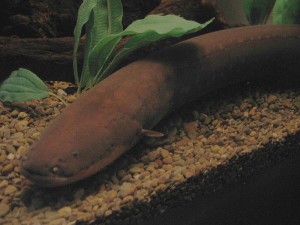
In my youth, I was a tropical fish hobbyist. I had many amazing fish in my aquaria. Among my favorites was the knife fish. Now I never would have had an electric eel in my fish tanks. Yet, the electric eel is a kind of knife fish! Electrophorus electricus can produce more than 500 volts. This grotesque creature is a danger to many moderate sized creatures, such as humans.
The electric eel is native to northeastern South America. It may reach more than 8 feet¹ in length. E. electricus usually dwells in rivers, but can inhabit swampy areas. They prefer to remain in darker regions. The skin of the electric eel protects it from being shocked by its own current.
Three Questions
It is good to ask three questions about the electric eel. First: what organ or organs are the source of the electricity? Next, what happens at the cellular level? Finally, can comprehending the process enable technological progress? Let us see.
The Source
To begin with, consider an ordinary flashlight battery. You recall a battery has a positive end and a negative end. Does this correspond in any way to the electric eel? Yes, it does. The area behind an eel’s head is positive, while the tail end is negative. This indicates the organs generating the electricity are large and spread out. They fill most of an eel’s body.
The electric organs are three in number. An electric eel’s built-in radar system utilizes the lower voltage producing Sach’s organ. The higher producers are the Main organ and Hunter’s organ. They are pictured in this excellent anatomical diagram.
At the Cellular Level
At the cellular level, there are small structures called electrocytes. These are about 1/25-inch in thickness and are comparable to nerve cells. There are some 250,000 of these cells. These are fairly evenly spaced and evenly layered. Individual electrocytes produce around 0.10 volts.
Those in the same layer connect serially. This compares to our using three 1.5 volt D-cell batteries in series in a flashlight to produce 4.5 volts total. There appear to be some 5,000 electrocytes “wired” in series. 5,000 cells times a tenth of a volt equals 500 volts. The layers (believed to be roughly 50 in number) appear to be wired in parallel. This increases current and power capability.
At the Sub-Cellular Level
Since nerve cells do not touch one another, what is the wiring between them? The “wires” are ion channels.² The electricity is produced electrochemically. Research at the sub-cellular level continues.³
Electric Eel Like Future Technology
Man made electrical cells are being developed by electric eel researchers. Since implant devices used in the human body do not require much electricity, a few of them, devised along the lines of eel electrocytes should do. Properly engineered, they would be capable of recharging themselves, even as the electric current of an electric eel, recharges quickly. Patients would benefit from fewer surgical procedures.
1 2.5 meters
2 The ions involved are Na+, K+, and Ca+2
3 See Comparative Biochemistry and Physiology, Vol. 119, Issue 1, January 1998, Pages 225-241.
Note: You might also enjoy Our Year-Round Indoor Red Wiggler Earthworm Farm
References:
- University of Michigan: Museum of Zoology: Electrophorus electricus
- Yale News: Researchers Design Artificial Cells That Could Power Medical Implants
- Archive.org: Free 12 minute downloadable movie!

[…] eel radar system [diagram], Quirky Science, viewed 25 January 2017, <https://www.quirkyscience.com/electric-eel-produces-electricity/ […]
I can’t help but feel a mix of fascination and apprehension towards the electric eel. Its ability to generate over 500 volts is truly astounding, but also a cause for concern for creatures like us. The intricate anatomy of the electric eel, with its three electric organs and thousands of interconnected electrocytes, reveals a complex system at work. It’s intriguing to think that researchers are harnessing this natural phenomenon to develop self-recharging implant devices, offering hope for future medical advancements.
Fascinating read! I remember once, during a trip to South America, being cautioned about the electric eels in a local river. Never would I have imagined the intricacies of their electrical system could potentially revolutionize medical technology.
This is a fascinating read! I had no idea that electric eels are a type of knife fish and that they can produce such a high voltage. The comparison to flashlight batteries really helped me understand how their electric organs work. Your explanation of the cellular and sub-cellular processes was both detailed and easy to follow. It’s incredible to think that research on these creatures could lead to advancements in medical technology. Thank you for sharing such intriguing information!